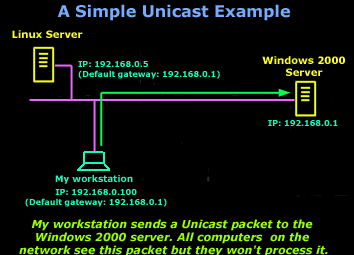Unicast
Introduction
Compaired to broadcasts
and Multicasts, a
Unicast is very
simple and one of the most common data
transmissions in a network.
The Reason for Unicast
Well it's pretty obvious
why they came up with
Unicasts,
imagine trying to send data between 2 computers
on a network, using broadcasts ! All you would
get would be a very slow transfer and possibly a
conjested network with low bandwidth
availability.
Data transfers are almost
all of the times, unicasts. You have the sender
e.g a webserver
and the receiver e.g
a workstation.
Data is transfered between these two hosts only,
where as a broadcast or a multicast is destined
either everyone or just a group of computers.

In example above, my
workstation sends a request to the
Windows 2000 Server.
The request is a
simple Unicast
because it's directed
to one machine (the server) and nothing
else. You just need to keep in mind that
because we are talking about a Ethernet
network, the traffic, hence the packets, are
seen by all machines (in this case the Linux
Server aswell) but they will not process
them once they see that the destination MAC
address in the packets do not match their
own and are also not set to
FF:FF:FF:FF:FF:FF
which would indicate
that the packet is a broadcast.
There really isn't
much more to say for
Unicasts...
so I guess i'll stop right here :)
|
|
Back |
Top |
Next-Controlling Broadcast & Multicast |
| |
|
|
|
